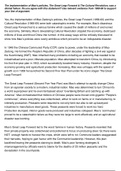Dissertation
History Grade 12 Implementation of Mao Zedong's Policies - Paper 1 - Achieved 96% in Final NSC History Exam
- Cours
- Établissement
Yes, the implementation of Mao Zedong’s policies, the Great Leap Forward (1958-62) and the Cultural Revolution (1966-69) were both catastrophic events. For example, Mao’s disastrous Great Leap Forward led to a serious famine which caused the death of millions of and ruined the economy. Similarl...
[Montrer plus]



